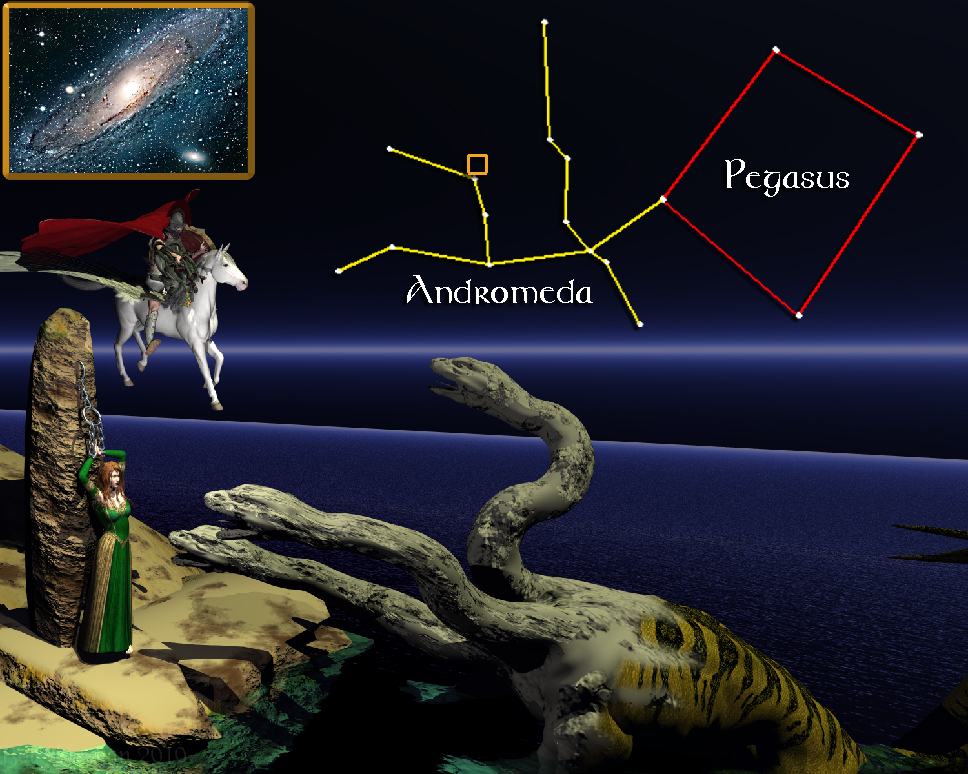
For the week including August 27, 2010

ANDROMEDA
After sunset, the constellation of Andromeda, the Chained Maiden, rises above the eastern horizon, bringing with it one of the very best deep space objects available to amateur stargazers.
In one of Greek mythology’s most enduring stories, Andromeda was the daughter of Cepheus and Cassiopeia, apocryphal rulers of ancient Æthiopia. Cassiopeia’s enormous vanity got her into trouble with the gods who over-reacted a little by sending Cetus the sea-monster to destroy their country. Cepheus and Cassiopeia decided to sacrifice their daughter to the creature with the hope of appeasing the wrath of Olympus. And so it was that Andromeda found herself chained to a rock at the shore while her parents rang the dinner bell. In the nick of time, Andromeda’s boyfriend Perseus flew in on the winged horse Pegasus. He had just finished work on another myth co-starring the former beauty-queen named Medusa. Normally, carrying the head of a demon so hideous that any who gazed upon it turned to stone won’t boost your popularity, but it was pretty handy for this legend. Perseus showed Medusa’s head to Cetus and the monster obligingly turned to stone without getting even a nibble of Andromeda. This tale was a favorite of the Greeks and they commemorated all of its characters among the stars. Cepheus and Cassiopeia, Andromeda and Perseus (who holds Medusa’s head), Pegasus and even Cetus, the Sea-Monster are prominent constellations today.
After the Sun is well down,look toward the eastern horizon and you will see the constellations of Pegasus and Andromeda. Locate the star, Alpheratz, in the left corner of the Great Square of Pegasus. On a dark night, in the left side of your field of vision, you will see a faint blur of light. (Astronomers often use this indirect observing technique called “averted vision” because the human eye picks up faint light best when the light source is just outside the center of focus.) Shown in the photograph by Robert Gendler at upper left, the blur you see is the Great Andromeda Galaxy. At a distance greater than two million light years, this galaxy is the most distant object visible to the naked eye. When seen for the first time, Andromeda’s size in the sky is breathtaking, but an idea of its scale is better obtained with binoculars or a backyard telescope. You’ll be impressed immediately with the immense glow of Andromeda’s trillion stars spreading across a wide area of space. At nearly 200,000 light years across, the Andromeda Galaxy is one of the largest galaxies known, and rivaled in size by our own Milky Way. One of the reasons the Andromeda Galaxy is so big is that it may have “eaten” a few smaller galaxies that were wandering by. A telescope will also reveal the galaxies M32 and M110 that are trapped by Andromeda’s tremendous gravitational pull. In the Andromeda photograph, M32 is the tight ball of stars sitting on the galaxy’s upper rim while M110 appears as a larger patch hovering below it.
Unless otherwise indicated, all content of this web site is the copyright of Robert Deegan and all rights are reserved.
For more information, or to comment, please contact: Bob@NightSkies.org